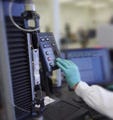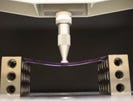Helping Medical Devices Pass Their Tests
From combination products to orthopedic implants, medical device testing is critical to ensuring that safe and effective products are brought to market
January 26, 2013
Cutting-edge combination products and novel orthopedic implants are improving treatment and enhancing patient care. But their complex nature has resulted in increased FDA scrutiny and a demand for more information to ensure the safety and efficacy of devices hitting the market. As a result, more-thorough medical device testing has become paramount. In turn, accommodating FDA's requests, optimizing devices, evaluating materials, and getting products to market quickly and on budget is putting medical device manufacturers to the test.
Scrutinizing Combination Products
Transdermal patches, specialty orthopedic implants, and drug-eluting stents are just a few of the medical devices that are fueling a rapidly growing market for combination products. As the industry anticipates a healthy future with combination devices, however, medical device manufacturers face a number of emerging challenges in regard to testing and regulatory affairs when bringing these hybrid products to market.
"A lot of the requests we're getting are from companies taking medical devices and fusing them with pharmaceuticals," remarks Eric Hill, business marketing and sales manager at Impact Analytical (Midland, MI). Impact's customers include manufacturers of drug-delivery patches, heart stents, and catheters, among others.
Testing such devices often focuses on whether the combination product contains the intended level of active pharmaceutical ingredients (API). It is also imperative to identify unwanted impurities and extractables, such as residual monomers in polymeric substances. "We always hear about bisphenol A (BPA) in consumer products," Hill adds, "but there's also BPA in medical devices."
|
EAG Life Sciences provides analytical support for extractables and leachables projects. |
While there are definite cost, efficiency, and enhancement-of-care benefits to infusing medical devices with drugs, the medical device industry expects that such complex products will undergo more-rigorous regulatory scrutiny over time than noncombination devices, Hill notes. Thus, Allen Kesselring, director of scientific affairs at EAG Life Sciences (Maryland Heights, MO) observes that although formal regulatory requirements have not changed significantly, EAG is seeing an increase in FDA requests for additional information about combination products. "One thing that has definitely changed in the last couple of years is that the agency is reviewing these devices in a more thorough and detailed manner than before," he says.
In the last few years, FDA has increased its scrutiny of submitted information during the 510(k) review process in particular, says Jim Fentress, product development engineer at Gilero Biomedical (Research Triangle Park, NC). "This trend," he adds, "means that when a company files for 510(k) approval, there are more questions and a higher information threshold on what they expect to see from us."
That information threshold is particularly high for combination products because such products require regulatory filings for both the device and the API, Fentress comments. "A good example is an asthma inhaler. The device has to atomize the drug to the right particle size distribution so that a suitable therapeutic dosage reaches the right lung tissue. But the drug safety and pharmacokinetics must be well understood, independent of the device."
To carry out this more-stringent approach, FDA often collaborates with its colleagues from the Center for Drug Evaluation and Research (CDER). "Traditionally, CDER is the agency that evaluates pharmaceutical products, and as such, it looks at details associated with extractable leachables," Kesselring explains. "In the past, it never really touched medical devices."
EAG's testing experience with extractable leachables in pharmaceutical products and inhalation devices, for example, is enabling the company to meet the challenges posed by additional requests from the agency, Kesselring says. "We're able to help guide medical device companies that come to us and say, 'we've never had this question asked before.'"
Working with medical device clients involves compliance with various subsections of ISO 10993 that are associated with the chemical compatibility and chemical release aspects of the device. These aspects formally require gravimetric evaluation. However, FDA has been requesting information associated with more chemically specific means of testing using gas chromatography-mass spectroscopy (GC-MS), liquid chromatography-mass spectroscopy (LC-MS), and inductively coupled plasma mass spectrometry (ICP-MS). The company often works with a toxicologist to review the test results in order to confirm that no unsafe compounds or impurities are present, Kesselring notes.
In addition to regulatory challenges, such medical device testing can also present cost concerns, Kesselring adds. "For example, the costs associated with chemically specific evaluation of unknown compounds using GC-MS, LC-MS, and ICP-MS can be significantly different from previous budget amounts. A study can cost anywhere from $15,000 to $20,000 for a smaller study involving a few contact materials to over $100,000 for some projects." The cost depends on what FDA is expecting and the specific portion of the device to be tested, he adds.
Materials Testing
Combination products are hardly the only medical devices that must undergo extensive testing. Thus, the large number of orthopedic implant manufacturers coming to Sherry Laboratories (Daleville, IL) are looking to test materials in both raw and finished states, remarks Jennifer Tret, the company's vice president of materials testing. On the device side, for example, surgical-tool clients using the lab's services work with stainless steel and cobalt-chrome alloys that require routine mechanical testing for tensile strength, grain size, microstructure, and surface defects.
Most of the company's testing services involve heat qualification of bar stock or coated finished products at a quality assurance lab, Tret says. But for orthopedic components, it also employs cyclic dynamic and fatigue testing to determine how many cycles the material can withstand and how much quality load it can take.
Sherry Laboratories primarily uses ASTM test methods, starting with ASTM 466 through ASTM F-1854 to calculate tissue gradients. "ASTM F-1854 has just been created, and we've done some round-robin testing to help get it off the ground," Tret states. The end-user may specify the need to measure tensile strength, for example, while finished products may have specifications for coating thickness, porosity, and voids.
Test Plan Development
|
Included in Gilero Biomedical's range of testing services is force measurement testing of medical device components. |
When people have a new idea and new products, they want to expedite time to market, which helps to minimize overall developmental costs. But manufacturers with innovative designs, Fentress notes, often face difficulty because the engineering work is not the only facet of the development process to consider. "There's a cost-prohibitive threshold that makes device design difficult," Fentress says.
Achieving this goal of minimizing time to market and development costs requires a rock-solid product-requirements document, Fentress adds. "Essentially, this document links the device users' needs to the specific engineering requirements of the device. Often customers have a good device idea, but they haven't yet hammered out what they really need the device to do. The way to minimize development time is to hammer those details down."
The product-requirements documents should also encompass test plan development. "Sometimes, test plan development can be a sanity check on product development itself," Fentress says. The customer might set the gravity flow rate of a new medical device at, say, 4 L/hr. That might be okay, but there's an international standard that says it should flow at 6 L/hr." In such cases, Gilero advises the manufacturer to meet the international standard. An efficient testing plan validates the product requirements.
Medical device customers often want to know how a new design feature could change the regulatory pathway, particularly with Class II filings for 510(k) clearance, Fentress remarks. By evaluating new products against predicate devices, however, customers may be able to get their products to market without performing clinical trials. This process doesn't have to be expensive or painful, Fentress adds. Often testing adjustments can take place within the time frame allotted for designing the device. "Maybe a different flow-rate test or burst test is all you need to do.
About the Author(s)
You May Also Like




